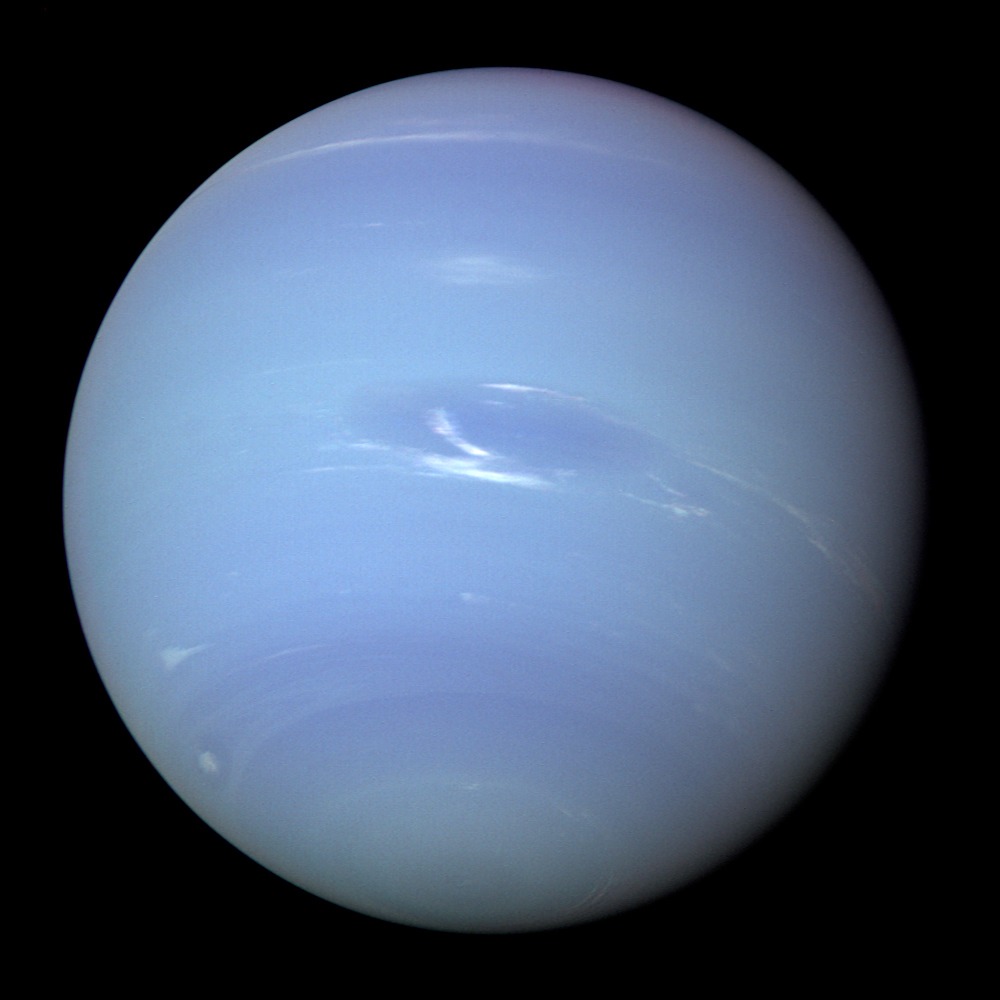Neptune was the first planet discovered through mathematical calculations instead of a telescope. It was discovered in 1846 by the German astronomer “Johann Gottfried Galle” and the French astronomer and mathematician “Urbain Le Verrier.”
This dark and cold planet is also known as the “Ice Giant.” Following are some interesting facts about this planet:
1. The Most Distant Planet
Neptune has a distance of around 4.4757 billion kilometers from the sun, making it the farthest planet.
2. The Smallest Gas Giant
There are four gas giants in our solar system, i.e., Jupiter, Saturn, Uranus, and Neptune. Among these four gas giants, Neptune is the smallest one.
3. A Year on Neptune
Due to the wide orbit, Neptune’s one year equals 165 years of Earth. Neptune completes its one orbit around the sun in 165 Earth years.
4. The Name of Neptune
The planet was named after the Roman God of water/sea. It was because of the blue color of this planet. In the beginning, it was assumed that this blue color came from the water present on Neptune.
5. Rings of Neptune
There are five known main rings and four prominent ring arcs around Neptune. The five main rings were named Galle, Leverrier, Lassell, and Adams, respectively. However, the four arcs are named as, Liberté, Egalité, Fraternité, and Courage.
6. The Thin Rings
Neptune’s rings are very thin, and it is believed that these rings are made from ice particles, dust, and particles coated with some carbon substance.
7. Ancients Had No Idea About This Planet
It was because of its distance that Neptune couldn’t be seen with the naked eye. The position of Neptune was discovered through mathematical predictions.
8. Moons of Neptune
Fourteen moons orbit Neptune. The most alluring, interesting, and biggest one out of these 14 moons is “Triton.” Triton is full of frozen nitrogen and dust that keeps spewing from its surface. Triton might be the coldest astronomical unit of our solar system.
9. It Spins Rapidly Around Its Axis
All the Gas Giants in our solar system spin faster around their axis. Neptune is also a gas giant, and it is believed that this fast-spinning occurs due to the collisions that happened when the planet was being formed. It only takes 16 hours for Neptune to complete one rotation around its own axis.
10. The Smallest Ice Giant
There are only two planets in our solar systems nicknamed “Ice Giants”; Uranus and Neptune. Neptune is the smallest one of these Ice Giants.
11. Atmosphere
Neptune’s atmosphere is made out of Helium, Hydrogen, and Methane. The methane present in its atmosphere absorbs the red light, due to which the planet gets its beautiful blue color. There are also thin clouds present in Neptune’s atmosphere.
12. Climate
The climate on Neptune is relatively active. There are storms and strong winds actively whirling throughout the upper atmosphere of Neptune. The high-speed wind travels at a speed of 600 meters per second. Neptune’s most enormous storm was seen in 1989, named “The Great Dark Spot.” This storm lasted for five years.
13. Spacecraft on Neptune
Only one spacecraft, named “The Voyager,” ever flew by Neptune in 1989. This spacecraft sent down the very first images of Neptune and the system around it. Further study about the planet was done through NASA’s Hubble Space Telescope.
Some Other Information about Neptune
Neptune’s upper atmosphere is made from a mixture of Hydrogen (80%), Helium (19%), and traces of methane. The deep blue color of this planet is because of the presence of methane in its atmosphere. Uranus’s atmosphere is almost the same, but the color of Neptune is more profound than the Uranus. The reason might be the presence of some other components in the atmosphere.
The weather patterns of Neptune were also studied, and two were observed. The first weather pattern was the one that was seen in the images sent by The Voyager 2 flyby mission – the Dark Spots. The second weather pattern was also observed through The Voyager 2, and it was the white storm system in a swift motion. This storm system was named “Scooter.”
Like the other gas giants of the solar system, Neptune also has an atmosphere divided into latitudinal bands. In these bands, the average wind speed is estimated at around 600 meters per second.
Neptune does not have three layers of the interior; it is only made of core and mantle. The core of Neptune is believed to be rocky and massive (1.2 times heavier than Earth). However, the mantle is said to be made of dense liquid that is extremely hot. Scientists believe that the mantle of Neptune consists of ammonia, methane, and water.
Just like other Gas Giants, Neptune rotates faster than other planets. This is why it is the third planet to have the shortest day. The orbit of Neptune is almost round because of the very little eccentricity in its orbit. Its orbit’s eccentricity is .0097, which is the second shortest (the first is of Venus).
Neptune is a Gas Giant, due to which there is not much solid surface available on it. Due to the lack of a solid surface, it is nearly impossible for this planet to hold life on it. However, Neptune’s moon Triton can be a place to create a space colony. The images of Triton sent by the Voyager 2 show that there are rocky and smooth areas present on Triton.
Conclusion
Neptune looks like a ball of water, but the color comes from other aspects of its atmosphere. There is so much more information to be collected and studied about Neptune yet. Being the farthest planet, Neptune has always been a problematic unit to explore about. The astronomers and scientists have already gathered information about its orbit, surface, climate, and much more. But we can never say that the current information is enough; there must be much more to know about.
Let’s see what information the future holds for space lovers.
